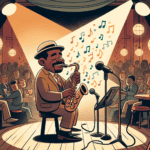The Clarinet in Contemporary Jazz: A Unique Voice
The clarinet in contemporary jazz recordings is a fascinating topic, filled with interesting trivia and unique perspectives. Jazz, known for its fluidity and improvisation, has always embraced the clarinet, making it an important part of its musical landscape. Whether you're just starting out or you're a seasoned pro, there's always more to discover about this versatile instrument and how it fits into jazz.
One of the standout features of the clarinet in jazz is how well it blends with other instruments while still maintaining its own distinct sound. Unlike the saxophone or trumpet, which can often take center stage, the clarinet tends to weave in and out of the music, adding its own special flavor without overwhelming the group.
Famous Jazz Clarinetists: From Clarinet to Stardom
Here's an interesting fact: many well-known jazz musicians began their careers playing the clarinet before branching out to other instruments. Take Artie Shaw and Benny Goodman, for example. They, along with many others, started their musical journeys with the clarinet. The instrument's versatility and range made it a hit during the swing era, and it continues to be loved by jazz musicians today.
| Musician | Known For | Notable Works |
|---|---|---|
| Artie Shaw | Swing Era Bandleader | “Begin the Beguine” |
| Benny Goodman | “King of Swing” | “Sing, Sing, Sing” |
| Sidney Bechet | New Orleans Jazz Pioneer | “Blue Horizon” |
Recording the Clarinet: Challenges and Techniques
Recording a clarinet in a jazz setting comes with its own set of challenges and techniques. Things like where you place the microphones, the acoustics of the room, and even the type of reed used can really affect the sound quality. Many professionals like to use ribbon microphones because they give a warm, natural sound that works well with the clarinet's tone. Also, trying out different recording spaces can lead to some interesting and varied results – you might get the cozy feel of a small jazz club or the big, open sound of a concert hall.
Modern Technology in Clarinet Recording
Technology has changed how we record the clarinet. Digital audio workstations (DAWs) and virtual instruments give us endless ways to tweak and improve the audio. But even with all these new tools, what really makes a great recording is still the skill and artistry of the musician. It's the little things like how they control their breath, their finger technique, and how they express emotion that really bring the clarinet to life in a jazz recording.
The Importance of High-Quality Instruments
We can't talk about great clarinet playing without mentioning the importance of good instruments. Companies like Martin Freres have built a reputation for making clarinets that sound great and are well-crafted. Having a good instrument can make a musician feel more confident, letting them focus on their performance instead of worrying about technical issues. This is particularly important in jazz, where being spontaneous and expressive is key.
Memorable Moments in Jazz Clarinet History
Jazz history is full of stories about amazing, off-the-cuff clarinet solos that left audiences amazed. These moments often become legendary, passed down from one generation of musicians to the next. For instance, people still talk about Benny Goodman's surprise solo during a live show at Carnegie Hall, showing just how captivating and surprising the clarinet can be.
The Cultural Impact of the Clarinet in Jazz
The clarinet's role in jazz goes beyond just the technical aspects. It's been a way for musicians to express all kinds of emotions, from the excitement of a lively swing tune to the sadness of a bluesy ballad. This ability to convey such a range of feelings is one reason why the clarinet has stuck around through all the different phases of jazz history and why contemporary musicians still love it.
The Clarinet's Role in Jazz Ensembles
The clarinet doesn't just shine in solos. It often helps with harmony, contributes to the melody, and adds depth to the overall sound. In a big band, for example, how the clarinet section plays with the brass and rhythm sections is really important for getting the right musical balance.
Exploring Clarinet in Jazz: Listening Recommendations
To really get a feel for how the clarinet fits into contemporary jazz, it's worth listening to a variety of recordings. Check out some albums by Dave Brubeck, who sometimes included clarinet in his group. These can give you a good idea of what the instrument can do and how smoothly it fits into jazz compositions.
Getting Hands-On: Exploring Jazz Clarinet
If you're interested in exploring what the clarinet can do in jazz, try joining some jam sessions or collaborating with other musicians. These situations are great for trying out different styles, techniques, and approaches, which can really help you improve your skills and boost your creativity.
Wrapping Up: The Clarinet's Place in Contemporary Jazz
While the clarinet might not always be the main attraction in contemporary jazz, it plays a vital and enriching role. From providing subtle harmonies to delivering amazing solos, the clarinet's contributions to jazz are incredibly valuable. As you discover more about this fantastic instrument, take a moment to appreciate the skill and artistry that goes into every note, making the clarinet a true gem in the world of jazz music.
Table of Contents
- The Clarinet in Contemporary Jazz: A Unique Voice
- Famous Jazz Clarinetists: From Clarinet to Stardom
- Recording the Clarinet: Challenges and Techniques
- Modern Technology in Clarinet Recording
- The Importance of High-Quality Instruments
- Memorable Moments in Jazz Clarinet History
- The Cultural Impact of the Clarinet in Jazz
- The Clarinet's Role in Jazz Ensembles
- Exploring Clarinet in Jazz: Listening Recommendations
- Getting Hands-On: Exploring Jazz Clarinet
- Wrapping Up: The Clarinet's Place in Contemporary Jazz







